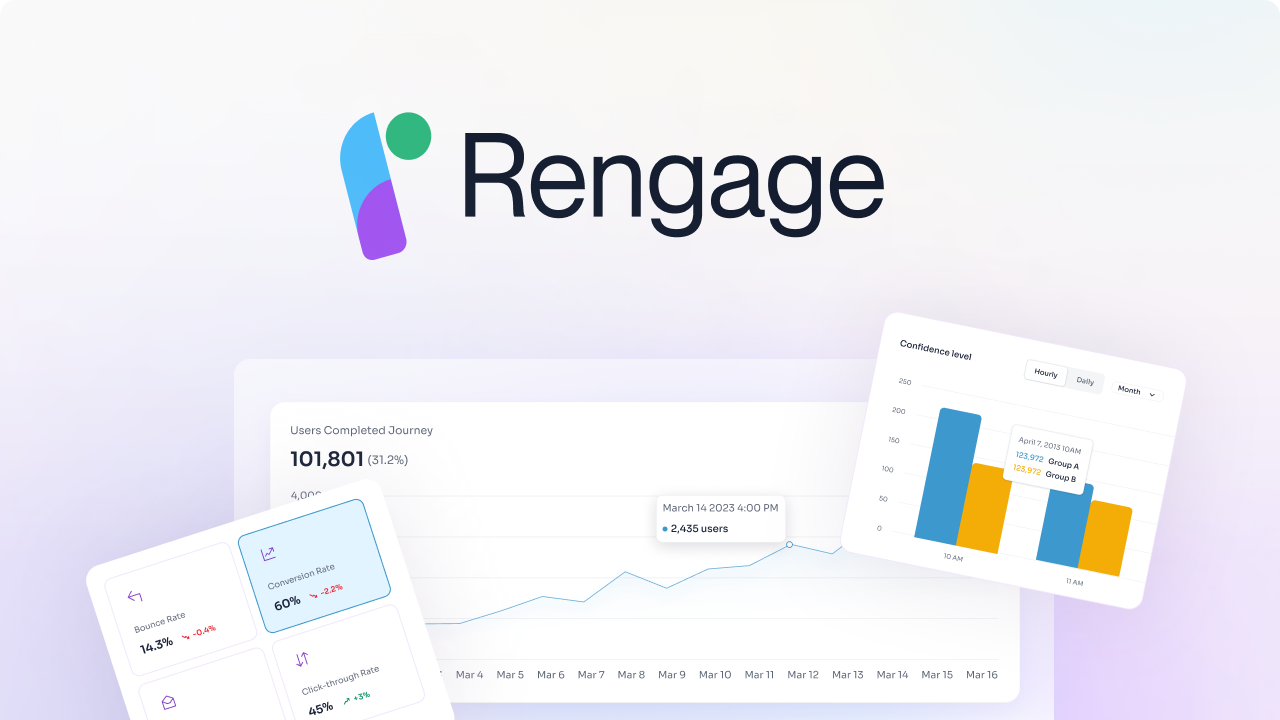Customer Segmentation Analysis is a vital component of customer data platform use cases, allowing businesses to transform customer experiences into personalized interactions that elevate loyalty and growth. Imagine accurately anticipating your customers' needs and preferences, tailoring your products or services to their preferences. This article will shed light on how customer data platform use cases can breathe life into such scenarios, helping you unlock your potential for creating individualized experiences that drive customer loyalty and business growth.
Rengage's solution drives loyalty and growth. We help you realize your goals of transforming customer experiences into personalized interactions, ultimately enhancing loyalty and business growth.
What Is a Customer Data Platform?

A Customer Data Platform (CDP) is software that compiles and manages comprehensive customer data for analyses, tracking, and customer interaction management. CDPs collect and unify customer data from various sources to create a central database accessible by other systems.
The key benefits of utilizing a CDP include creating a single customer view, enabling personalized marketing campaigns, and enhancing customer segmentation and targeting. Unlike CRMs and DMPs, CDPs are specifically designed for marketing purposes, focusing on building complete customer profiles for targeted and personalized marketing strategies.
How to Utilize a Customer Data Platform (CDP)
Businesses can leverage a Customer Data Platform (CDP) in numerous ways to enhance their marketing efforts and improve customer engagement. These use cases include connecting online and offline interactions, customer segmentation for targeted marketing, personalized customer experiences, lead scoring for prioritizing sales opportunities, retargeting and lookalike advertising, product recommendations, A/B testing for optimizing campaigns, omnichannel automation, improved email deliverability, generating better online reviews, enhancing customer lifetime value (CLV), and enhancing conversion rates.
Differentiating CDPs from CRMs and DMPs
While CDPs, CRMs, and DMPs all deal with customer data, they serve distinct purposes and functions within the marketing landscape. CRMs focus on sales and customer relationship management, providing tools to improve customer relationships and manage interactions. DMPs, on the other hand, are designed for advertising, specifically supporting web display advertisements.
In contrast, CDPs are tailored for marketing purposes, aggregating first-party customer data from multiple sources to build integrated customer profiles for targeted and personalized marketing campaigns. CDPs work seamlessly with DMPs and CRMs, allowing marketers to maximize their marketing efforts and improve customer experiences across various channels.
7 Key Functionalities of a Customer Data Platform

1. Collecting first-party data
First-party data is crucial for any organization, as it gives a more accurate view of the customer. The CDP lets you collect individual-level data from online and offline sources. This data covers both current and potential customers and their behaviors with the company. Since this data is gathered directly from the source, it tends to be more precise than second or third-party data collected by other entities. Operating on first-party data also assists in complying with international data protection laws, as you are more likely to obtain valid consent for its collection by asking the users directly.
2. Data privacy and management
With a CDP, you can address data quality from the point of collection and maintain its integrity throughout the data pipeline. You have governance over the data collected and maintained in the CDP and control over the sources of information. This centralized data provides a single source of truth regarding a customer's data and the processing purposes users have agreed to. If requested, the CDP also enables quick modification or deletion of specific user data.
3. Single customer view
The CDP unifies and attributes the collected information to individual users, providing access in single customer views. These profiles incorporate all gathered information, like demographics, purchase history, and behavioral data. By understanding all touchpoints of the customer journey, you can gain insights into their interests, potential future purchases, or the need for personalized discounts to re-engage after a period of inactivity.
4. Identity resolution
A CDP can tie disparate data from multiple channels to the same customer profile through identity resolution. This process merges data using matching identifiers like e-mail addresses, user IDs, or cookie IDs. Using multiple identifiers provides an advantage over analytics tracking tools that often depend on cookies tied to a browser, not a specific user. Relying on cookies for user data can lead to downstream data quality issues, especially when connecting cookie-based data to other tools and systems.
5. Audience segmentation
Segmentation is fundamental for creating audiences that group customer profiles matching specific conditions. Once audience segments are built in your CDP, you can send them to downstream tools for data activation. Centralized audience segmentation saves time and guarantees that the segments are consistent and up-to-date across systems.
6. Data activation
Data activation involves translating customer data insights into action in other systems and tools. For example, you can add users from a specific audience to an email list and send them a discount code or display an ad banner on the website with a complementary product based on their previous purchases. The CDP's integrations enable businesses to access data where and when needed, freeing engineers from managing third-party code.
7. Work in real-time
CDPs empower marketers to work in real time, enhancing the process of preparing audience segments or targeting users with relevant content. Customer information is reflected in real time in updated profiles. As a result, the data sets expand, letting you constantly access up-to-date customer details.
Book a free demo to learn how to transform customer interactions into personalized experiences that drive loyalty and growth.
Related Reading
- Customer Data Infrastructure
- Omnichannel Analytics
- Customer Data Integration
- Predicting Customer Behavior
- Marketing Data Platform
- Customer Data Platform Vs Data Management Platform
- Best Customer Data Platform
- Customer Data Platform Capabilities
- Customer Data Platform Tools
- How To Choose Cdp
10 Compelling Customer Data Platform Use Cases

1. Unified Customer Data
Unifying customer data is the most common CDP use case. The first step in creating a data-driven customer experience is to compile a 360° view of your customer, but forming this view can be challenging when your data is scattered across systems and teams. A customer data platform must be able to unify data from any and all sources in your organization — from your website and call center systems to your customer relationship management (CRM) system and beyond. Without this, you’ll lack a single source of truth for your customer data, meaning your marketing efforts will be based on incomplete or inaccurate data and, therefore, likely fall flat.
2. Enhanced Personalization
After collecting and unifying your customer data and then cleaning and deduplicating it, you can mine that data to generate a more robust understanding of your customers, which will help you personalize their journey with your brand. Use your CDP to build segments of your customers based on their behaviors, so you can enhance your future engagements with them.
Customer segments can be created based on various factors, such as browsed product categories, web pages visited, spending level, in-store engagement, etc. You can deploy customized experiences that align with their behaviors and preferences using these segments. Going deeper, you can also support personalized marketing at the individual level by using insights from your CDP.
3. Mapping the Customer Journey
Businesses increase sales when they understand the touchpoints that convert a prospect into a paying customer or where they may get hung up in their customer journey. To get that big picture view, organizations pull data from chatbot interactions, product pages visited, on-site event attendance, visitor origin (SMS, email, or social media), and so on to map the customer journey.
A CDP offers a solution by providing a centralized location for all that data, so marketing teams can more easily produce informed customer journey maps and, by extension, strategies that optimize the customer experience.
4. Optimized Customer Experience
A CDP-informed customer-journey map offers a solid foundation for improving CX delivery. Once an organization knows where pain points in the customer journey occur — perhaps a specific step during checkout often leads to abandoned carts — then teams can go about righting the ship.
CDPs with machine learning (ML) baked in can enhance customer experiences even more. How? ML-enabled CDPs derive insights, such as behavioral patterns, from huge datasets that would take humans months, if not years, to analyze.
5. Multichannel Messaging
Once your customer data is unified and you have a complete profile of your customers, you can use your CDP to optimize marketing campaigns across all online and offline channels. With a customer data platform, you can deliver the right message to the right individual through the right channel.
6. Fewer Privacy Risks
As consumer views on data privacy grow more conservative, audiences have begun demanding more from organizations, such as consent before data collection. A CDP can help organizations meet these privacy changes by combining data to produce a so-called “golden record” for a unified view of a single customer.
7. Actionable Analytics
Remember that a CDP is not just another database to store your customer data and then forget about it. A customer data platform’s value comes from the insights you derive from it to inform your marketing strategy. Your marketing team can use these insights to design campaigns to keep these audiences engaged or find similar, “lookalike” customers who can be nurtured into becoming future best customers. With actionable analytics, a CDP brings your customer data to life, enabling smarter, more successful marketing.
Related Reading
- Customer Retention Automation
- Customer Data Integration Best Practices
- Real Time Customer Segmentation
- Chat CDP
- Customer Data Platform Implementation
- Benefits Of A Customer Data Platform
- Customer Segmentation Solutions
- Omnichannel Measurement
- AI Customer Segmentation
- AI CDP
- Customer Data Platform GDPR
- Customer Data Platform Costs
- CDP Personalization
Top 18 Customer Data Platform (CDP) Vendors to Consider
1. Rengage

We provide a comprehensive solution for managing and enhancing customer journeys, delivering insights and measurable outcomes with no code. We accelerate your customer journey from onboarding, activation to conversion and churn. Enabling customers to unlock revenue from their existing user.
With Rengage, you can get insights into your segments, run campaigns with an intuitive journey manager, and get insights to measure how your journeys impact users conversion through our Journey Moments and Journey Builder features.
- Journey Moments: insights into your micro-segments
- Journey Builder: intuitive multi-channel marketing automation
- Insights prediction and attribution.
Book a free demo to learn about how you can transform customer interactions into personalized experiences that drive loyalty and growth.
2. Segment
Segment is a customer data platform by Twilio that enables users to collect and route their customer data to various integrated systems. It is favored because of its easy setup, real-time tracking, and modifiable dashboards. This customer data platform allows you to send data to multiple destinations. It also includes some really cool features, such as cross-channel engagement design (journeys), a way of customizing your data pipeline (functions), and a simplified way of transforming and loading customer data (warehouses).
3. Bloomreach Engagement
Bloomreach is a commerce experience cloud that acquired Exponea this year and incorporated its customer data platform capabilities into its product kit. The Bloomreach CDP, called Bloomreach Engagement, offers online and offline data tracking, a unified single customer view, and advanced customer data analytics. It also has some great machine learning aspects and predictive recommendations, which make it really intuitive.
4. Totango
Totango’s DNA-CX (Dynamic No-Schema Active Customer Index technology) is an intelligent customer data platform that lets users connect all customer data streams. This software is great for segmenting your customers and seeing different metrics, which help you identify which customers you need to prioritize.
5. Blueshift
The Blueshift Smarthub Customer Data Platform is another great option if you’re looking for a CDP to deliver real-time experiences throughout the entire (omnichannel) journey. It’s extensive AppHub also provides users with a wide variety of data integrations, which is certainly a plus! Fan favorites on this platform include real-time data unification, audience segmentation, 1:1 personalization and predictive intelligence.
6. Insider
Ranked among the world’s top 5 marketing platforms on the Forrester Wave for Cross-Channel Campaign Management, Insider is certainly a top-rated customer data platform. The platform enables marketers to connect their data across various channels, predict future behavior with its AI intent engine, and create individualized customer experiences.
7. Tealium AudienceStream CDP
Tealium AudienceStream Customer Data Platform is a great customer data platform if you’re looking to bring together fragmented chunks of data from all kinds of data sources and bring it together. Leverage various business rules and enrich your data as it flows in. Unique features of AudienceStream (the platform built into Tealium) include identity resolution, data enrichment and cross-channel audience management. The platform offers over 1300+ turnkey integrations, allowing users to connect their systems and data effortlessly.
8. Listrak
As a cross-channel marketing platform, Listrak offers various ‘components’, including unified customer data. It’s a great platform for those seeking versatility and top-notch automation capabilities. Users are pleased with the data visualization capabilities, AI recommendations, and predictive analytics features. This platform requires a bit more onboarding due to its steeper learning curve.
9. Lytics
Lytics is ideal for digital marketers looking to build personalized digital experiences quickly and easily using an affordable platform. According to G2, Lytics’ ability to identify and target specific users within a segment has proven instrumental in how many organizations conduct business. Depending on how large your data segments are, the platform can be a bit on the slower side.
10. Treasure Data
Treasure Data is a well-known customer data platform that enables its users to unify all kinds of data, including marketing hubs, IoT, weblogs, and geolocation data. This CDP offers 150 out-of-the-box connectors, so you can bring this data together easily and in real time. It’s also got a great up-to-the-minute real-time data analysis feature so that users always know what’s going on their digital channels.
11. BlueVenn by Upland Software
BlueVenn, recently acquired by Upland Software, is a customer data platform and omnichannel marketing hub. What’s great about this platform is that it offers easy-to-use data loaders and an intuitive user interface that requires little to no support from IT. This browser-based solution also includes drag-and-drop analytics, predictive insights and segmentation tools.
12. SAP Customer Data Platform
Just over a year ago, SAP launched its own Customer Data platform. This new technology focuses on four main priorities: connecting data from multiple sources, purpose-driven data governance, processing large volumes of data, and hyper-personalizing using a 360-degree customer view. It also offers a back-office system connection and real-time insight activation.
13. Microsoft Dynamics 365 Customer Insights
Microsoft Dynamics 365 Customer Insights is — you guessed it! — a part of Microsoft’s customer data platform (CDP) that helps deliver personalized customer experiences. The solution is divided into two segments: audience insights and engagement insights. Audience insights focus on connecting data from transactional, behavioral, and observational sources for a 360-degree view, whereas Engagement insights enable users to understand how customers behave on the various channels.
14. Oracle Unity
Oracle Unity is an attractive CDP for B2C and B2B brands that aggregate traditional marketing and advertising data, including online, offline, and third-party customer data sources. Looking to connect individuals across devices, channels, domains, and networks and create accessible profiles using advanced privacy and identity controls? Then this might be the CDP for you.
15. Salesforce Interaction Studio
This tool is particularly useful for streamlining offline and online customer interactions. It leverages AI technologies to segment customer data and helps users personalize interactions based on existing portfolios and the customer’s previous behavior. What’s more, this data is all gathered in real time from every digital touchpoint, including web, mobile, retail, advertising, and phone.
16. RedPoint Global
RedPoint Global is a comprehensive customer data platform that gives businesses a signal view of the customer. Offering hundreds of out-of-the-box connectors, users can ingest data from a wide range of different sources. This CDP also leverages predictive models and machine learning to optimize customer decisions. Part of the RedPoint Customer Engagement Hub, users also have access to in-line analytics and intelligent orchestration.
17. Emarsys
Emarsys is a customer engagement platform with robust CDP capabilities for streamlining customer data. The company serves over 1,500 businesses in the retail, e-commerce, travel, sports, consumer products, and media industries. Emarsys includes predictive analysis, automated AI-based updates, reporting and analytics, and cross-channel automation and personalization. You can also explore industry-specific solutions for the e-commerce, travel, and retail sectors.
18. Optimove
Optimove is a relationship marketing hub with CDP functionality. Used by 500+ customers, the GDPR- and ISO-certified platform creates single customer views with first-party data, third-party data, and campaign response history. This allows the platform to segment data, enabling businesses to create personalized multichannel campaigns. With Optimove, you can access scalable data infrastructure, customizable dashboards, predictive customer analytics, and other features to boost customer engagement.
How to Choose the Right CDP for Your Business

1. Get Stakeholder Buy-In
When choosing a CDP, it's crucial to get buy-in from internal stakeholders. This includes allies from sales, IT, customer success, marketing, and finance departments. Having IT involved ensures compatibility with your tech stack, while input from other teams helps understand what they expect from a CDP.
2. Outline Core Challenges or Use Cases
Identify specific use cases that go beyond data consolidation. This will help you find a CDP that aligns with your brand's needs. Reach out to peers in similar companies to learn about the CDP solutions they use for similar challenges, and build a shortlist of potential vendors.
3. List Tools to Connect to Your CDP
Knowing the tools you'll connect to your CDP is essential for evaluating vendors and assessing their integrations. This step helps in ensuring that your CDP integrates with pre-existing systems. Incompatibility should lead to the elimination of a potential vendor.
4. State the Capabilities of Your Ideal CDP
Consider core capabilities such as data governance, quality enforcement, compliance, identity resolution, control over roles and permissions, volume of data storage, and more. For instance, if your company handles sensitive customer data, look for an ISO 27001- or SOC 2-certified CDP.
5. Compare CDP Vendors
Assess recommendations, check pricing pages, and read comparison pages on platforms like G2 and Capterra. Not all CDPs are equal; some may be better suited for small businesses, while others cater more to midmarket and enterprise companies. Narrow down your search accordingly.
Related Reading
- CDP Marketing Automation
- Customer Data Platform Vs Marketing Automation
- Ecommerce Cdp
- Totango Competitors
- Centralized Marketing Data
- Customer Data Management Best Practices
- Segment Alternatives
- Blueconic Cdp
- Emarsys Competitors
- Actioniq Competitors
Create Personalized Experiences That Drive Loyalty and Growth with Rengage — Book A Free Demo Today
Rengage offers a comprehensive solution for managing and enhancing customer journeys, delivering insights, and measurable outcomes with no code. We accelerate your customer journey from onboarding, activation to conversion, and churn, enabling you to unlock revenue from your existing user base. With Rengage, you can get insights into your segments, run campaigns with an intuitive journey manager, and measure how your journeys impact user conversion through our Journey Moments and Journey Builder features.
Journey Moments: Insights into Your Micro-Segments
Rengage's Journey Moments feature offers insights into your micro-segments. By diving deep into your customer segments, you can better understand their behavior, preferences, and needs. This enables you to tailor your marketing efforts more effectively, delivering personalized experiences that resonate with your customers. With detailed insights into each micro-segment, you can create targeted campaigns that drive engagement and conversion.
Journey Builder: Intuitive Multi-Channel Marketing Automation
Rengage's Journey Builder feature allows you to effortlessly create intuitive multi-channel marketing automation campaigns. With drag-and-drop functionality and a user-friendly interface, you can seamlessly design complex customer journeys that span multiple touchpoints. Whether you want to onboard new users, reactivate dormant customers, or encourage repeat purchases, Journey Builder makes it easy to map out the ideal customer journey and automate communications across different channels.
Insights Prediction and Attribution
Rengage's Insights Prediction and Attribution feature provides you with valuable insights into the performance of your customer journeys. By tracking key metrics and attributing conversions to specific touchpoints, you can understand which marketing efforts drive results and optimize your campaigns accordingly. With data-driven insights, you can make informed decisions about your marketing strategy, refine your customer journeys, and maximize your ROI.
Book a Free Demo with Rengage Today!
Ready to transform your customer interactions into personalized experiences that drive loyalty and growth? Book a free demo with Rengage today to learn more about our customer data platform and how it can help you unlock revenue from your existing user base. With Rengage, you can gain valuable insights, run targeted campaigns, and measure the impact of your customer journeys, empowering you to drive sustainable growth and build lasting customer relationships.
